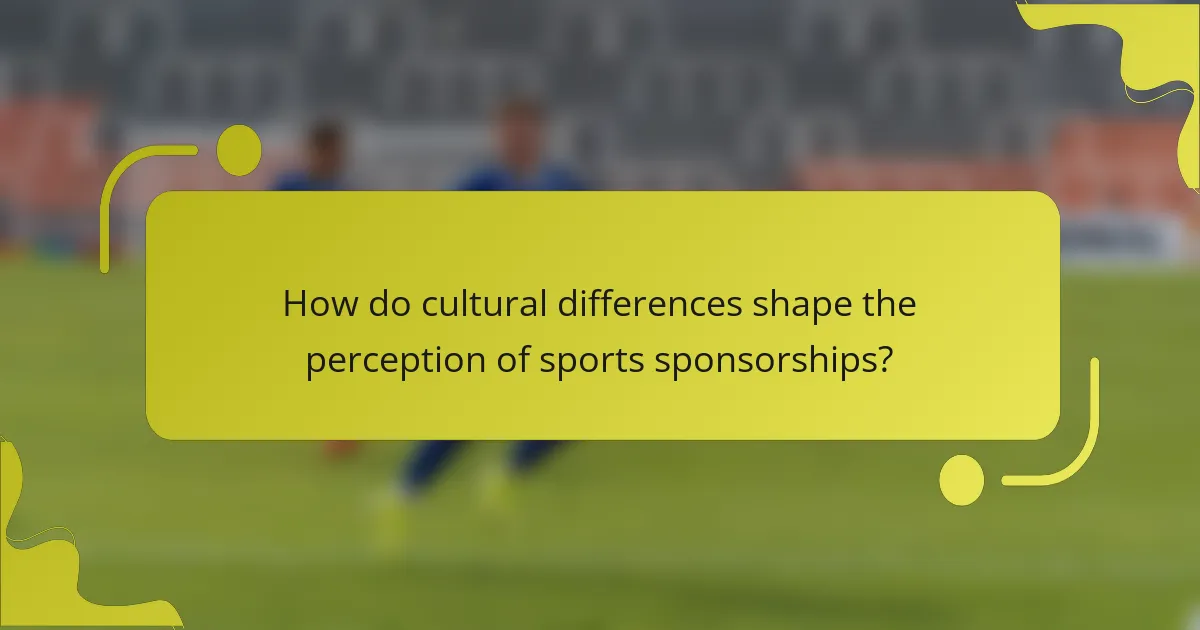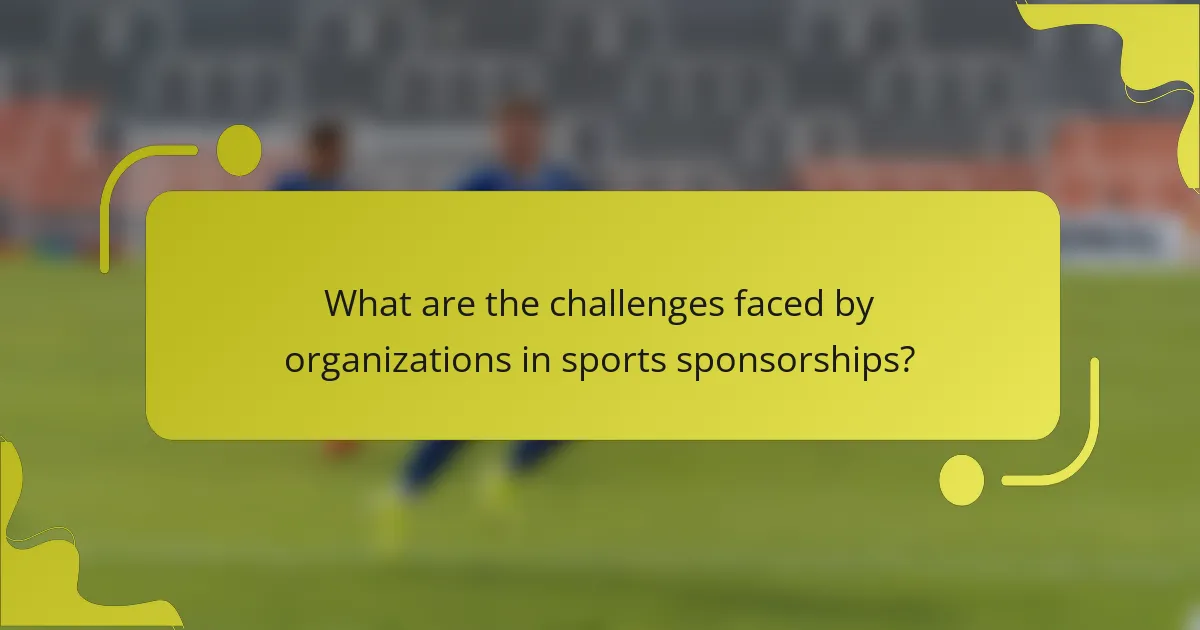Sports sponsorships play a crucial role in enhancing local community engagement and driving economic growth. They provide essential funding for local teams and events, increasing attendance and boosting local businesses. Cultural influences shape perceptions and effectiveness, while organizations face challenges like high costs and measuring ROI. Successful campaigns prioritise community engagement and measurable impact, fostering loyalty and driving sustainable development.

How do sports sponsorships influence local community engagement?
Sports sponsorships significantly enhance local community engagement by fostering economic growth and social connections. They provide funding for local teams and events, creating opportunities for residents to participate and connect. Sponsorships can lead to increased attendance at local sporting events, which boosts local businesses and generates revenue. Furthermore, community-focused initiatives funded by sponsors often address local needs, strengthening the bond between the sponsor and the community. For example, initiatives like youth sports programmes and health campaigns promote active lifestyles and community well-being. Overall, sports sponsorships serve as a catalyst for community development and unity.
What are the key benefits of sports sponsorships for local communities?
Sports sponsorships provide significant benefits for local communities, enhancing economic growth and social cohesion. They create job opportunities, stimulate local businesses, and promote community engagement through events. Additionally, sponsorships can improve public facilities and foster youth development programmes, enriching the community’s overall quality of life.
In what ways do sports sponsorships foster community identity and pride?
Sports sponsorships significantly enhance community identity and pride by fostering local engagement and unity. They create shared experiences through events that bring people together, promoting a sense of belonging. Sponsorships often support local teams, which can boost community morale and encourage participation in sports.
Additionally, they can drive economic growth by attracting visitors for games and events, benefiting local businesses. Communities often rally around sponsored teams, leading to increased local pride and identity. This connection can result in long-lasting relationships between sponsors and the community, reinforcing social ties and collaborative initiatives.
How do local events benefit from sports sponsorships?
Local events benefit significantly from sports sponsorships by enhancing community engagement and driving economic growth. Sponsorships provide funding that supports event organisation, increases attendance, and boosts local businesses.
Additionally, they create a sense of pride and unity within the community. Local sponsors often promote their brand alongside events, leading to increased visibility and customer loyalty. This partnership fosters a vibrant local culture, attracting visitors and stimulating further economic opportunities.
For instance, a study indicated that communities with strong sports sponsorships experience a 20% increase in local business revenue during events. This impact highlights the vital role of sponsorships in promoting sustainable community development.

What is the economic impact of sports sponsorships on local businesses?
Sports sponsorships significantly boost local businesses by enhancing visibility and driving sales. Local enterprises often experience increased foot traffic and customer engagement during sponsored events. For instance, a study found that local restaurants near sports venues saw a 30% rise in sales on game days. Additionally, sponsorships create networking opportunities, fostering collaborations among businesses. This economic uplift contributes to job creation and overall community development. As a result, the symbiotic relationship between sports sponsorships and local economies is evident, driving growth and sustainability.
Which sectors are most positively affected by sports sponsorships?
Sports sponsorships positively affect various sectors, including local businesses, tourism, and community development. Local businesses benefit from increased foot traffic during events. Tourism experiences growth as visitors flock to sponsored events, boosting hotel and restaurant revenues. Community development sees enhancements through funding for local sports programmes and facilities.
How do sports sponsorships drive tourism and local spending?
Sports sponsorships significantly enhance tourism and local spending by attracting events and visitors. Major sporting events draw fans, leading to increased hotel bookings, dining, and retail sales. For example, cities hosting large tournaments often see a surge in economic activity, with local businesses benefiting from the influx of visitors. Sponsorship deals also promote the host city, enhancing its visibility and appeal as a travel destination. As a result, communities experience long-term economic growth through sustained tourism and investment in local infrastructure.
What metrics are used to measure the economic benefits of sports sponsorships?
Economic benefits of sports sponsorships are measured using metrics such as increased local business revenue, job creation, and enhanced community engagement. These metrics provide insights into the direct and indirect economic impacts of sponsorships on local communities.
| Metric | Description | Value |
|—————————-|————————————————–|—————————————-|
| Local Business Revenue | Increase in sales for local businesses | Up to 20% growth during events |
| Job Creation | Number of jobs created due to sponsorships | Hundreds to thousands per event |
| Community Engagement | Participation rates in sponsored events | 30% increase in local attendance |
| Brand Exposure | Reach and impressions of sponsors | Millions through media coverage |
| Economic Multiplier Effect | Overall economic impact on the local economy | 1.5 to 3 times the initial investment |

How do cultural differences shape the perception of sports sponsorships?
Cultural differences significantly influence perceptions of sports sponsorships, affecting community engagement and economic benefits. Local values and traditions shape how sponsorships are viewed, with some cultures prioritising community support while others focus on brand visibility. For instance, in collectivist societies, sponsorships that promote local initiatives resonate more deeply. Conversely, in individualistic cultures, the emphasis may be on the prestige associated with international brands. Economic growth from sports sponsorships also varies; regions with strong cultural ties to sports often experience greater local investment and participation. These cultural nuances create unique sponsorship landscapes, impacting overall effectiveness and community relations.
What regional variations exist in sports sponsorship strategies?
Regional variations in sports sponsorship strategies reflect local economic conditions and cultural preferences. Urban areas often attract larger sponsorship deals due to higher visibility and audience engagement. In contrast, rural regions may rely on community-centric sponsorships that support local teams and events. For instance, sponsorship strategies in the U.S. emphasise brand visibility through major leagues, while European countries may focus more on grassroots initiatives. Regions with strong sports traditions typically see sponsors aligning with local values, enhancing community support and economic growth. This localised approach fosters a unique identity for sponsors and strengthens community ties.
How do local sports sponsorships reflect community values?
Local sports sponsorships significantly reflect community values by fostering unity and promoting local pride. They enhance economic growth by supporting local businesses and creating job opportunities. Sponsorships often align with community interests, such as youth development and health initiatives. For instance, a study found that communities with active sports sponsorships reported a 20% increase in local engagement. This connection between sponsorships and community values strengthens social bonds and encourages participation in local events.

What are the challenges faced by organizations in sports sponsorships?
Organizations face several challenges in sports sponsorships, including high costs, unclear ROI, and market saturation. High sponsorship fees can strain budgets, particularly for smaller businesses. Measuring the return on investment remains complex, as benefits are often intangible. Additionally, the crowded market makes it difficult for brands to stand out, leading to competition for attention. These factors can hinder effective partnerships and limit community impact.
How do sponsorship conflicts arise in local sports?
Sponsorship conflicts in local sports arise when multiple brands compete for visibility and association with the same team or event. These conflicts can lead to confusion among fans and dilute brand messaging. Additionally, they may result in financial disputes if sponsors feel their investments are undermined by competing interests. Local communities often face challenges in balancing sponsor expectations with community values, which can impact overall economic growth and community engagement.
What are the common pitfalls organizations encounter in sports sponsorships?
Organizations often face challenges in sports sponsorships that can hinder their effectiveness. Common pitfalls include misalignment of brand values, lack of clear objectives, inadequate audience engagement, and failure to measure return on investment. Misalignment occurs when the sponsor’s values do not resonate with the sports entity’s image, leading to ineffective partnerships. Without clear objectives, organizations may struggle to gauge success and optimise their strategies. Engaging the local community is crucial; neglecting this can result in diminished support. Lastly, failing to measure ROI can leave organizations unaware of the sponsorship’s true impact on economic growth and community development.

Which unique attributes distinguish successful sports sponsorship campaigns?
Successful sports sponsorship campaigns are distinguished by their community engagement, brand alignment, measurable impact, and innovative activation strategies. These unique attributes create meaningful connections between brands and local communities.
Community engagement fosters loyalty and support, enhancing the campaign’s reach. Brand alignment ensures that the sponsored entity resonates with the target audience, maximising relevance. Measurable impact provides data that demonstrates the campaign’s effectiveness, driving future investment. Innovative activation strategies create memorable experiences, increasing brand visibility and consumer interaction.
These attributes collectively contribute to the success and sustainability of sports sponsorships, driving economic growth within local communities.
What role do local partnerships play in enhancing sponsorship effectiveness?
Local partnerships significantly enhance sponsorship effectiveness by fostering community engagement and driving economic growth. Collaborations with local businesses create shared value, increasing visibility and support for sponsored events. These partnerships often lead to higher attendance rates, stronger community ties, and improved brand loyalty. For example, local sponsors can provide essential resources, while sponsors can elevate local initiatives, creating a mutually beneficial relationship. This synergy amplifies the overall impact of sports sponsorships within local communities.
How do innovative marketing strategies amplify sponsorship impact?
Innovative marketing strategies significantly amplify the impact of sports sponsorships on local communities and economic growth. By leveraging social media, experiential marketing, and community engagement, brands enhance visibility and foster deeper connections with local audiences.
For example, targeted campaigns that highlight local athletes or community events can create a sense of pride and belonging. As a result, businesses see increased customer loyalty and community support, driving economic benefits.
Additionally, integrating sustainability initiatives into sponsorships can attract environmentally conscious consumers, further enhancing brand reputation and community impact. This approach not only promotes local development but also aligns with broader societal values, making sponsorships more relevant and effective.
In summary, innovative marketing strategies transform sports sponsorships into powerful tools for community engagement and economic advancement.

What best practices should organizations follow for effective sports sponsorships?
Organizations should prioritise community engagement, clear objectives, and measurable outcomes for effective sports sponsorships. Engaging local communities fosters goodwill and enhances brand loyalty. Setting specific goals, such as increasing attendance or promoting health initiatives, ensures alignment with community needs. Measuring success through metrics like local economic impact or social media engagement provides insights for future sponsorships. Additionally, collaborating with local organizations can amplify the positive effects on economic growth and community development.
How can organizations measure the success of their sports sponsorships?
Organizations can measure the success of their sports sponsorships through various metrics and feedback mechanisms. Key performance indicators include brand awareness, community engagement, and economic impact. Surveys and focus groups can gauge public perception and sentiment. Additionally, analysing sales data and foot traffic during sponsored events provides quantitative insights. Tracking social media engagement and media coverage can also reveal the sponsorship’s reach and effectiveness. Ultimately, aligning these metrics with specific objectives enhances the evaluation process.
What strategies can enhance community involvement in sports sponsorships?
Engaging local communities in sports sponsorships requires targeted strategies. Building partnerships with local organizations fosters trust and enhances visibility. Utilizing social media campaigns can increase awareness and participation. Hosting community events promotes interaction and showcases sponsorship benefits. Offering incentives, such as discounts or exclusive access, encourages local support and strengthens ties.
What common mistakes should be avoided in sports sponsorship initiatives?
Avoiding common mistakes in sports sponsorship initiatives is crucial for maximising community impact and economic growth. Key mistakes include insufficient research on target demographics, neglecting local community engagement, and failing to set measurable objectives. Additionally, overlooking the importance of aligning sponsorships with brand values can diminish effectiveness. Lastly, not evaluating the return on investment can lead to wasted resources and missed opportunities for improvement.




